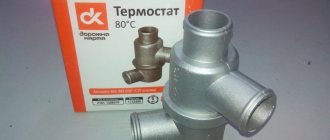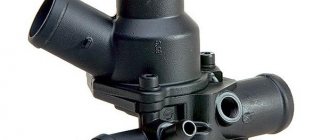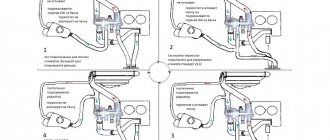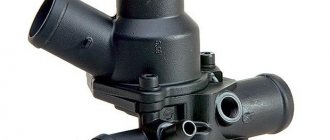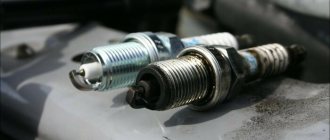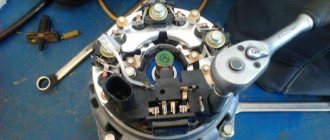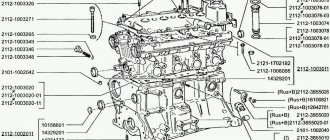Thermostat for Niva 21213 which is better
An internal combustion engine is designed to operate at a certain temperature. Only within a certain range of heating of the coolant are the correct temperature gaps of the rubbing parts and the factory-set characteristics observed. To speed up warm-up, the coolant first passes through a small circuit (bypassing the radiator).
Then, as it heats up, the flow is redirected along a large circuit through the radiator. If necessary, the cooling fan is also forced to turn on. Thanks to this three-stage system, heating occurs more evenly and operating temperature is reached faster. To switch antifreeze between cooling circuits, a special valve is provided - a thermostat. It opens under the influence of a certain temperature and is a regulator of engine cooling. This item is actually a consumable. If it breaks down, the thermostat needs to be replaced, since it cannot be repaired. Correct operation of the thermostat is especially important on vehicles operated in difficult conditions: for example, SUVs. NIVA 2121 falls into this category. When driving off-road, the engine works under heavy load and gets very hot. And external cooling by air flow is not effective due to the low speed. It is in such a situation that a broken thermostat can lead to overheating of the internal combustion engine and deformation of the cylinder block.
The malfunction can be determined independently, without special diagnostics. During normal operation of the thermostat, the internal circuit pipe heats up first. As the temperature rises, after the valve is activated, the outer pipe also becomes hot. The engine overheats even though the cooling fan is working and the antifreeze level is normal. External signs: after warming up the engine, the internal circuit pipe is hot, the external circuit pipe is cold. Malfunction - the valve is constantly closed.
If such malfunctions are detected, it is necessary to dismantle the thermostat and check its functionality in a container with hot water. A thermostat is placed in the pan, the water is heated (constant stirring is required).
When the valve opening temperature is reached (checked with a thermometer), a working thermostat should work.
In the NIVA 21214 car, the valve is conveniently located; there is no need to dismantle adjacent elements. No special tools are required - just a Phillips screwdriver is enough. You may also need a flat blade screwdriver to pry up stuck hoses. Drain some coolant to a level below the connection between the pipes and the valve. Cover the generator with plastic wrap. If antifreeze gets inside the generator, this will entail a labor-intensive operation to clean and dry it. It is even possible that electrical equipment may fail, and the generator will have to be replaced.
Next, you need to loosen the clamps on the inlet pipes and check their free movement. When replacing, do not pull off the hoses with a sharp movement, as this may damage the pipe or cause injury.
After making sure that the joints are not stuck, unscrew the clamps until they sag and separate the pipes. Be prepared to catch any leaking antifreeze; you can use a rag to cover it. Inspect the supply pipes. If there are cracks or large creases, replace them. After removing the part from under the hood, inspect it for fallen springs or other metal parts.
If there is a foreign object left in the pipe, you will have to change the water pump as well. Before installing a new thermostat, thoroughly wipe the internal surfaces of the pipes to remove any deposits. Be careful not to allow debris to get inside the cooling system. Attach the new valve in reverse order. First, tighten the screws fully and check the connections for rubber kinks. Then crimp the clamps all the way. Add antifreeze to the standard level and start the engine. Check the joints for leaks. Check the functionality of the thermostat by touching the hoses of the circuits.
F O R U M
Replacing the thermostat
An internal combustion engine is designed to operate at a certain temperature. Only within a certain range of heating of the coolant are the correct temperature gaps of the rubbing parts and the factory-set characteristics observed. To speed up warm-up, the coolant first passes through a small circuit (bypassing the radiator).
Then, as it heats up, the flow is redirected along a large circuit through the radiator. If necessary, the cooling fan is also forced to turn on. Thanks to this three-stage system, heating occurs more evenly and operating temperature is reached faster. To switch antifreeze between cooling circuits, a special valve is provided - a thermostat. It opens under the influence of a certain temperature and is a regulator of engine cooling.
This item is actually a consumable. If it breaks down, the thermostat needs to be replaced, since it cannot be repaired. Correct operation of the thermostat is especially important on vehicles operated in difficult conditions: for example, SUVs. NIVA 2121 falls into this category. When driving off-road, the engine works under heavy load and gets very hot. And external cooling by air flow is not effective due to the low speed. It is in such a situation that a broken thermostat can lead to overheating of the internal combustion engine and deformation of the cylinder block.
The malfunction can be determined independently, without special diagnostics. During normal operation of the thermostat, the internal circuit pipe heats up first. As the temperature rises, after the valve is activated, the outer pipe also becomes hot. The engine overheats even though the cooling fan is working and the antifreeze level is normal. External signs: after warming up the engine, the internal circuit pipe is hot, the external circuit pipe is cold. Malfunction - the valve is constantly closed.
If such malfunctions are detected, it is necessary to dismantle the thermostat and check its functionality in a container with hot water. A thermostat is placed in the pan, the water is heated (constant stirring is required).
When the valve opening temperature is reached (checked with a thermometer), a working thermostat should work.
In the NIVA 21214 car, the valve is conveniently located; there is no need to dismantle adjacent elements. No special tools are required - just a Phillips screwdriver is enough. You may also need a flat blade screwdriver to pry up stuck hoses. Drain some coolant to a level below the connection between the pipes and the valve. Cover the generator with plastic wrap. If antifreeze gets inside the generator, this will entail a labor-intensive operation to clean and dry it. It is even possible that electrical equipment may fail, and the generator will have to be replaced.
Next, you need to loosen the clamps on the inlet pipes and check their free movement. When replacing, do not pull off the hoses with a sharp movement, as this may damage the pipe or cause injury.
After making sure that the joints are not stuck, unscrew the clamps until they sag and separate the pipes. Be prepared to catch any leaking antifreeze; you can use a rag to cover it. Inspect the supply pipes. If there are cracks or large creases, replace them. After removing the part from under the hood, inspect it for fallen springs or other metal parts.
If there is a foreign object left in the pipe, you will have to change the water pump as well. Before installing a new thermostat, thoroughly wipe the internal surfaces of the pipes to remove any deposits. Be careful not to allow debris to get inside the cooling system. Attach the new valve in reverse order. First, tighten the screws fully and check the connections for rubber kinks. Then crimp the clamps all the way. Add antifreeze to the standard level and start the engine. Check the joints for leaks. Check the functionality of the thermostat by touching the hoses of the circuits.
Source
Replacing antifreeze VAZ 21214
Replacing the coolant is a regulated maintenance procedure, which is prescribed in the operating instructions. There is nothing complicated about it if you clearly and carefully follow the described action plan.
Suitable for Niva cars:
Coolant drain
Before starting the draining procedure, you should prepare tools, containers for used antifreeze, as well as new liquids for subsequent refilling. If protection is installed under the engine, it can also be removed for convenience.
Next, we perform the procedure for draining the liquid from the VAZ 21214 (Niva):
Fig.1 Fig.2 Fig.3 Fig.4 Fig.5
Flushing the cooling system
If there are deposits in the drained liquid or there is a transition from antifreeze to antifreeze, the system should be flushed. To do this you need to do the following:
Filling antifreeze into Niva 21214, 21213 without air locks
To fill new fluid into the cooling system, you can use the instructions described in the book on car repair and operation. But when doing this, motorists very often end up with air jams.
So, let's start filling it correctly:
Fig.1 Fig.2 Fig.3 Fig.4 Fig.5
The filling of the liquid is completed, all that remains is to wipe off the spilled antifreeze and wait for the engine to cool. With the car now cooled down, check the level in the expansion tank again and top up if necessary.
The capacity of the VAZ-21213 and VAZ-21214 engine cooling system on Lada Niva and Lada 4x4 (including the interior heating system) is 10.7 liters. The cooling system uses coolant with a freezing point of no higher than minus 40 degrees.
Composition of the VAZ-21213 and VAZ-21214 engine cooling system on Lada Niva and Lada 4x4.
— Engine cooling jacket. It is cast and surrounds the cylinders in the engine block, combustion chambers and gas passages in the cylinder head and intake pipe. - Radiator. — Mechanically driven fan or two electric fans. - Expansion tank. — Thermostat. — Coolant pump. — Heater radiator.
Diagram of the cooling system of a VAZ-21213 carburetor engine on a Lada Niva.
Diagram of the cooling system of the VAZ-21214 injection engine on a Lada 4x4 car.
Water pump for the engine cooling system of VAZ-21213 and VAZ-21214 on Lada Niva and Lada 4x4.
Coolant pump is vane, centrifugal type. Driven from the crankshaft pulley by a V-belt. The pump housing is aluminum. The roller rotates in a double-row bearing with a “lifetime” supply of lubricant. The outer ring of the bearing is locked with a screw. The pulley hub is pressed onto the front end of the shaft. On the rear there is a plastic impeller.
Thermostat from Shnivy to Niva (2121)
Thermostat from Shnivy to Niva (2121)
Post by Anatoly » 10 Dec 2010 22:20
An article in the magazine “Behind the Wheel” made me think about improving the standard cooling system, because cooling the engine in winter is a real problem. There was no desire to solder an additional pipe into the original thermostat, so I settled on the option of replacing the thermostat with a Shnivovsky one. Having additionally studied the articles on Niva-faq by Turner, Mason and Chocolate Hare, as well as St.Rangera, I made a shopping raid, as a result of which I purchased:
Thermostat LUZAR — 340 rub. Set of pipes LUZAR VAZ 21213 - 300 rub. Clamps in assortment 200 rub. (a few left) Hose Ø16mm - 90 rub. meter (I took a meter) Sealant - 40 rubles. There was about 0.5 liters of antifreeze.
Let's start the installation: Drain the antifreeze, dismantle the thermostat along with the pipes. We are figuring out the location of the new thermostat, I decided to put it higher and in a horizontal position, as was done on Shnivy. We cut the pipes according to location. In general, nothing complicated, except for a couple of points: I plugged the outlet from the stove into the block with a stud of the GAZelle wheels, ran a hose from the outlet pipe of the stove to the thermostat (there is an electric pump in the section), put a suitable hose on the carburetor heating nipple (on the thermostat) and plugged it with a bolt. Fill with antifreeze and remove the plugs. ALL!
Installing a thermostat from a Chevrolet Niva - Lada 2106, 1.7 l., 2003 on DRIVE2
Replacing the thermostat in a VAZ 2110
Those who follow my BZ must remember the war between me and engine overheating (if they are not veterans of some Afghan war). As a result, after a long confrontation, I won and took thirtieth place in this category... from the endwww.drive2. ru/cars/lada/2…/288230376152379421/#postda won so much that the needle didn’t want to reach 90 (apparently I did a lot of damage to the whole system), even when I covered the radiator with cardboard, hammered it with boards and covered it with bricks (and this was in October ). That’s when I thought about it and imagined that in winter it wouldn’t be as warm as with a diesel engine.
Therefore, remembering an article I read a long time ago from the magazine “Behind the Wheel” www.zr.ru/articles/41822/I decided on such a revision. For the rework it is necessary: 1. Thermostat for Chevrolet Niva2. A pair of L-shaped pipes for draining antifreeze from the stove3. Clamps 4 pcs. 4. Possibly radiator pipes (I did without them) 5. Remove old parts 6. Patience and willpower
There are now plenty of articles on the conversion all over the Internet, so I won’t explain it in detail - they are not very suitable for demonstrating such things. I’ll just briefly write what needs to be done. Drain/suck out the antifreeze/antifreeze/water. Remove the old thermostat. We unscrew the tube from the pump through which coolant flows from the stove. We saw this tube approximately in half. We plug the hole where it was previously connected.
The hole in the pump is plugged, and the tube that was there before now leads the coolant to the thermostat
We install a new thermostat from Shnivy. Through L-shaped pipes and a cut tube we connect the drain from the stove to the thermostat. We also connect the pipe coming from the manifold to the thermostat. We fill in the coolant, bleed the air and rejoice at the work done if nothing leaks. If it flows, it’s a pichalka. We dig into the system with sealant and straight hands.
This is how it all looks to me
PS: During the conversion I encountered one problem. The angle of entry of the pipe into the thermostat from the radiator differs from the classic one, so you will have to puff.
Then, while the coolant was drained, I installed drain valves for myself, so that later it would be easier and without loss to drain the antifreeze, otherwise it costs money and I don’t want to pour it on the ground.
Radiator tap
Faucet on the block
Well, after the work was done, I went for a ride and checked the work... I couldn’t resist and stopped to take a photo against the backdrop of such beauty, although I don’t like this time of year, when the hellishly hot summer ends.
Well, after driving, I noticed that, as promised in the article, the coolant temperature does not drop when the heater is turned on. No, of course it drops a little (I noticed this when standing in a traffic jam and watched the fan turn on; with the heater on, it turns on less often). And when driving, the thermostat stably maintains its assigned 80+-2* degrees. Some people write that the engine warms up faster, but this is not so. If the thermostat is working properly, the warm-up time will be the same. The only difference between them is that the Shniv thermos keeps a more stable temperature on a WARM UP engine. And the engine temperature does not drop so much when the heater is turned on.
If anyone is interested or unclear, ask... someone =-))))
Lada 4×4 3D Niva “Blue Elk” › Logbook › Installing the thermostat 2123
The lower radiator pipe from the shnivy, trimmed in place, took the place of the original one, all the other pipes are made of long 2105.
The stove supply remains unchanged, the return requires changes. The rubber pipe remains in place, but the metal tube requires removal.
The remaining original heater outlet pipe was connected to the thermostat with a crankcase ventilation tube and an 18x26 hose. There is a small side outlet on the ventilation tube, onto which I put a short piece of silicone hose, it turned out to be a cool gadget for bleeding air from the system when pouring antifreeze. Now you no longer need to pour in a thin stream, everything fills perfectly, the bubbles come out.
Since the stove blew suspiciously weakly for the 08th snail, I carried out preventive maintenance, disassembled, cleaned, changed all the seals, filled the cracks with foam rubber, cut off the excess from the heater body, the snail body (there is a nivdush-2 stove), blew out the heater radiator with a pistol (it was summer very dusty).
The result was what I expected. The car warms up much faster, the stove starts blowing warm air from 40 degrees and the air flow has become even more powerful than when first installed.
Thermostat and pump from Chevrolet Niva - Lada 4×4 5D, 1.8 l., 2005 on DRIVE2
After reading the forums, the idea came up to install a thermostat and pump from Shniva.
The thermostat on Shniva works “more correctly” due to the fact that it has two additional inputs from the interior heater return and throttle heating. And the Shnivy pump has larger blades and a reinforced bearing with double seals.
We will need: - thermostat 2123 - pump 2123 - a set of cooling system pipes for 21213 - a hose from UAZ with a diameter of 18 mm (1m) and angles for it (6 pcs) - clamps in abundance - a short pipe for the thermostat from 2108 - a lower pipe for the radiator from the thermostat from Shnivy (or a pipe from a Priora which we cut off locally)
I decided not to split hairs and chose the Shniv location of the thermostat (lying down). This requires a minimum of modifications.
We unscrew the heater return line (the tube running below the manifold) and, sawing off the flange attaching to the pump, throw it away. Some people redo it, cut it, but I decided to do it differently. We weld a hole in the flange and screw it into place with sealant. We connect all the pipes to the thermostat and only the stove return remains. I made it from an 18-gauge hose and corners. Passed it in front of the collector. You can see everything in the photo. Having collected and filled the antifreeze, we remove the plugs and watch the work.
Effects: - quick warm-up - beyond 95 degrees the temperature did not rise even once during the day - the stove blows hot air even at speed 3 of the figure-eight snail
I am very pleased with the result of the work))
As it was here
stove return. Having installed the filter, I realized that the hose was in the way and I had to shorten the elbow and run it higher, a couple of cm from the manifold.
Issue price: 1,500 ₽
Cooling system. Radiator. Thermostat.
Re: Cooling system. Radiator. Thermostat.
Post by malunin » 24 Feb 2015, 09:51
Re: Cooling system. Radiator. Thermostat.
Post by Mikhail Belaya Niva » 24 Feb 2015, 10:55
Re: Cooling system. Radiator. Thermostat.
Post by al-awast » 24 Feb 2015, 13:43
Re: Cooling system. Radiator. Thermostat.
Post by Touareg » 24 Feb 2015, 21:06
Re: Cooling system. Radiator. Thermostat.
Posted by al-awast » 25 Feb 2015, 04:53
Re: Cooling system. Radiator. Thermostat.
Post by Stasyan » 25 Feb 2015, 08:04
Re: Cooling system. Radiator. Thermostat.
Post by Rastopchuk » 25 Feb 2015, 09:25
Re: Cooling system. Radiator. Thermostat.
Post by Anton773 » 25 Feb 2015, 09:48
Re: Cooling system. Radiator. Thermostat.
Post by Mikhail Belaya Niva » 25 Feb 2015, 09:54
Re: Cooling system. Radiator. Thermostat.
Post by Stasyan » Feb 25, 2015, 10:17 am
I just have to change the radiator anyway; it’s just in terrible condition and it’s leaking! He's still bigger and has no throat! So let's say it's a closed system.
As for the installation like on Drift2, I didn’t want to! When replacing the radiator, I want to install electric screws from 214 to different temperature sensors such as the ShN principle! and there he deepens the radiator into the TV in order to install a larger screw!
That's why I asked the question. maybe someone did the same. I would be glad to know all the nuances and pitfalls
Added after 4 minutes 13 seconds: And the desire to install all this so that the operating temperature is around 90.
In winter it’s a little cold, I just installed the 08 snail and in the 2nd position of the heater there is not enough heat to supply to the side and legs!
Comment
A point I want to draw special attention to. Cars of the Niva family have TWO temperature sensors. The first one since Fiat, stands on the block, about 4 candles. The second one is installed on the tee, at the beginning of the cylinder head. The first one gives readings only on the dashboard. The second is on the brains of the injector. Therefore, very often the question arises about the difference between the readings of the tidy and the BC. You need to trust the on-board computer, because it takes readings from a sensor that works with the ECU (electronic control unit).
Thermostat VAZ 2121, 21213, 21214, NIVA URBAN, OEM 2121-1306010
| Photo gallery | NIVA-SHOP | Files | Video |
| Brand | HQ-mech | ||
| Cat N | HQ-2121-1306010 | ||
| OEM N | 2121-1306010 | ||
| Applicability | VAZ 2121 | ||
| vendor code | 2006904758519 | ||
| Name | Thermostat VAZ 2121 | ||
| Unit measurements | PC | ||
| Amount in a package | 1 | ||
| Frequency of shipment | 50 | ||
| Price with VAT | 285 | ||
| Group | Auto parts | ||
| Length, mm | 120 | ||
| Width, mm | 90 | ||
| Height, mm | 107 | ||
| Unit weight | 0.34 | ||
| Certificate | RU C-CN.AD75.B.01105 |
Show all characteristics
Today, the auto parts market in Russia and the CIS offers a sufficient number of thermostats and thermoelements from various manufacturers - from “renowned” suppliers to the assembly lines of auto giants, to unknown brands and, unfortunately, obvious counterfeits of low quality. With this wide selection of auto parts, the difference in price can be tens and hundreds of rubles. How to buy a good “Thermostat VAZ 2121, 21213, 21214, NIVA URBAN, OEM 2121-1306010”
and not run into a fake? How to choose a truly high-quality spare part for a car that will serve reliably and for a long time? How not to overpay and get a part with an optimal price-quality ratio?
It's simple!
Buy a thermostat or thermostatic element of the HQ-mech brand
from Vistaservice LLC.
Why here?
Thermostat VAZ 21214 injector price
Add to Basket
| Brand | HQ-mech |
| Cat N | HQ-2121-1306010 |
| OEM N | 2121-1306010 |
| Applicability | VAZ 2121 |
| vendor code | 2006904758519 |
| Name | Thermostat VAZ 2121 |
| Unit measurements | PC |
| Amount in a package | 1 |
| Frequency of shipment | 50 |
| Price with VAT | 285 |
| Group | Auto parts |
| Length, mm | 120 |
| Width, mm | 90 |
| Height, mm | 107 |
| Unit weight | 0.34 |
| Certificate | RU C-CN.AD75.B.01105 |
Show all characteristics
Today, the auto parts market in Russia and the CIS offers a sufficient number of thermostats and thermoelements from various manufacturers - from “renowned” suppliers to the assembly lines of auto giants, to unknown brands and, unfortunately, obvious counterfeits of low quality. With this wide selection of auto parts, the difference in price can be tens and hundreds of rubles. How to buy a good “Thermostat VAZ 2121, 21213, 21214, NIVA URBAN, OEM 2121-1306010”
and not run into a fake?
How to choose a truly high-quality spare part for a car that will serve reliably and for a long time? How not to overpay and get a part with an optimal price-quality ratio?
It's simple!
Buy a thermostat or thermostatic element of the HQ-mech brand
from Vistaservice LLC.
Why here?
- More than 10 years of experience in auto parts production and sales
- We work only with proven factories and use only high-quality materials and raw materials (we place orders for the production of thermostats at factories focused on the European auto parts market and manufacturers of famous European brands)
- Use of modern high-tech equipment in production and mandatory quality control in production
- Well-thought-out and streamlined logistics (we do not overpay for storing goods at the port or in temporary storage warehouses)
- No bloated advertising budgets or overly large staff
- AND THE MOST IMPORTANT: we place orders, import to Russia and sell car parts without intermediaries.
Spare parts for cars under the HQ-mech brand have proven themselves well in the harsh climate of northern Russia, in the hot climate of the southern regions of the country, Africa and Latin America, as well as in the central European part. Vistaservice LLC is interested in long-term partnerships with service stations, retail stores, wholesale organizations and retail chains in the field of supply of automobile spare parts. We offer to buy thermostats, left and right wheel drives, wheel bearings, CV joints for LADA and GAZ, Daewoo and CHEVROLET cars, and more than 100 inexpensive but high-quality
auto parts wholesale, small wholesale and retail in Moscow and Tolyatia. We deliver throughout Russia. All products have TR CU certificates of conformity. We operate on a non-cash basis with VAT, and for individuals we operate an online retail store.
Applicability of Thermostat OEM No. 2121-1306010
| Brand | Model | Engine | Year |
| Lada (VAZ) |
| 21213 | 1.7 | 1993 — 2002 |
| 21214 | 1.7i | 2002 - present |
| 21214 Urban (14-) | 1.7i | 2014 - present |
| 4*4 (Niva) | 1.7i | 2002 - present. |
| 4*4 (Niva) | 1.8 | 1994 - present |
We invite wholesale organizations, service stations and stores to cooperate on an ongoing basis. We provide a full package of accompanying documents and a warranty from the manufacturer. We work with VAT, have all auto parts in stock, delivery throughout Russia and the CIS. Experience in the production of auto parts - more than 10 years.
code Luzar LT 0121
OEM number: 2121-1306010
Opening temperature, ?С: 80
Where can I buy
Applicability for vehicles
Brand name – LT – LuzarThermostat
Thermostats are necessary to direct the flow of coolant in the cooling system of automobile engines, thereby regulating the temperature of the coolant.
- when the temperature rises (usually at ≈80ºC), the main thermostat valve opens while the bypass valve closes;
- the radiator is included in the cooling circuit;
- the coolant temperature drops;
- When the temperature decreases, the reverse process occurs.
If necessary. more details
Brand name – LT – LuzarThermostat
Thermostats are necessary to direct the flow of coolant in the cooling system of automobile engines, thereby regulating the temperature of the coolant.
- when the temperature rises (usually at ≈80ºC), the main thermostat valve opens while the bypass valve closes;
- the radiator is included in the cooling circuit;
- the coolant temperature drops;
- When the temperature decreases, the reverse process occurs.
If you need to purchase a thermostat for a car, you need to know a few simple rules.
The operation of a car thermostat is characterized by two parameters:
The service life of a car thermostat depends on the degree of professionalism of the manufacturer and depends on the following points:
- thermostat designs
- pairing parts
- production technologies
- technical production capabilities
- raw materials used
- level of control of finished products
In turn, the accuracy of the auto thermostat is “revealed” by several indicators:
- opening temperature
- opening speed
- valve lift
- pressure at which the valve seals when closed
When choosing a thermostat, it should be remembered that two different vector requirements for the operation of the cooling system will depend on the indicated indicators - on the one hand, rapid warming up of the engine (and, therefore, a comfortable temperature in the car interior) and, on the other hand, the moment of “connection” to cooling radiator circuit (“large cooling circle”) to avoid engine overheating. It is the thermostat that solves the most important and controversial problem - to achieve the optimal engine temperature, while ensuring the absence of overheating, the flow of hot liquid into the heating radiator and comfort in the cabin, smoothing out the effect of “thermal shock”.
The simplest method of checking the thermostat is to put it in hot water and monitor the performance indicators indicated above.
LUZAR produces thermostats for both passenger cars, commercial vehicles and trucks. Today, LUZAR’s product range includes more than 20 models of thermostats for both domestic and imported cars.
New thermostats for all popular cars are being developed.
Which manufacturers of thermostats for Chevrolet Niva should you trust and how to replace them yourself?
Thermostat is a device in the engine cooling system that automatically regulates the temperature of the coolant. The device maintains optimal thermal operating conditions of the engine; with its help, the engine warms up faster.
Structurally, it is a valve, inside of which there is a heat-sensitive element that blocks the flow of water, antifreeze, antifreeze through the radiator until the engine is completely warmed up.
Installation location: in Chevrolet Niva it is located on the left front edge of the engine, connecting the lower pipe of the stove, pipes from the radiator, engine and throttle valve.
Vehicle cooling network design
The cooling system of the VAZ Niva is quite effective and has undergone virtually no changes since its creation. It includes the following units and elements:
Temperature control in the Niva engine cooling network is carried out in different ways. In the carburetor model VAZ-21213, a sensor is built into the cylinder head, connected to the temperature indicator on the dashboard. On the VAZ-21214 model, where the fuel is supplied by an injector, there is a second sensor mounted in the pipe on the cylinder head. It is connected to a controller that prepares the fuel mixture depending on the heating of the power unit and turns on the fans.
There are 2 more differences in the cooling design of engines with a carburetor and an injector:
In VAZ-2131 Chevrolet Niva cars, the cooling system is generally similar to a regular Niva with an injector. The VAZ-2131 heater radiator is not equipped with a tap, which is why antifreeze flows through it all year round.
Main element device
As for the cooling radiator, it is impossible to imagine the operation of the engine as a whole without it. It is represented by these components:
- upper and lower tanks;
- core;
- fastening parts.
Its main purpose is to cool the mixture coming from the water jacket to the required temperature standard. Good thermal conductivity is facilitated by the fact that it is usually made of brass. The core contains transverse plates. Once here, the reagent is divided into many streams - this allows you to get a more effective result.
The principle of operation goes like this:
- The pump constantly “moves” liquid into the VAZ 21214.
- The system operates in such a way that water circulates in a circle, washing the heated walls of the blocks and cylinder.
- In this case, engine overheating can be avoided, and heat will be guaranteed to be removed from important parts.
- Then the mixture goes through the radiator, and after that it is released into the environment.
- Thus, the cyclicity is completed - now the cooled liquid will have to repeat it again for the VAZ 21214.
Manufacturers and types
Standard sizes of thermostats, which by their design are suitable for installation in the engine of a Chevrolet Niva car, are produced by a number of global companies. The table below presents a list of products.
| Model | Product serial number | Opening temperature |
| Thomson | 21230-1306010-05-0 | 80° |
| Zommer | 2123-1306010 | 80° |
| Metal Inkar | 2123-1306010-01 | 80° |
| Pramo | 2123-1306010-02 | 80° |
| WEEL | 182-0114 | 80° |
| Luzar | LT0123 | 80° |
| Herzog | HL36010 | 80° |
| Vkt | VT29003 | 80° |
| Fenox | TS009E7 | 80° |
| Finord | 21231306010 | 80° |
| Baker | 21231306010 | 80° |
| Finwhale | FinwhaleT123 | 80° |
| Gallant | GLTH14 | 80° |
| Hofer | HF 445 730 | 80° |
There is an opinion among car owners that the highest quality, reliable and durable thermostats are products produced by Russian factories. There are currently three such enterprises:
Among foreign models, car owners have good reviews of the Metal Inkar model from the Polish manufacturer.
These products work great in the Chevrolet Niva cooling system, the engine warms up quickly, there are no complaints.
The only negative is that the body is made in two versions - plastic and brass. The second option is not very popular among drivers, although it also works well in a circuit.
Zommer, Luzar, WEEL thermostats should only be selected from approved manufacturers. There are a lot of fakes on the market and on the Internet. Retailers seek to sell their dubious products under the guise of original ones to newcomers in the automotive business. To avoid getting burned, when purchasing, you must require licenses, certificates and supporting documents from sellers.
About choice
Which thermostat is better for the VAZ-2110
AvtoVAZ catalog number: 2123-1307011-75.
It is equipped with a water pump produced by Tolyatti Automotive Units Plant CJSC (TZA).
On the shelves you can also find products from domestic SOATE, Fenox, Pekar. Of the imported ones, they are famous for the quality of products from Hepu (Germany), Graf (Italy), SKF (Germany - Spain).
The cost of a domestic unit starts from 880-900 rubles, imported ones can be found for 1900.
Counterfeit products from various shady manufacturers are very common on the market; outwardly they are practically no different from the original.
Important information:
- A high-quality pump is packaged in a plastic bag and a bright cardboard box. The packaging must include the catalog number, specifications, Russian and ISO certificate numbers.
- The product kit includes a gasket made of a special material similar to cardboard. A paronite gasket is a sign of a fake!
- It is advisable to choose a pump with a cast iron or steel impeller.
Also interesting: The principle of operation of the air conditioner of a Niva Chevrolet car
Articles and prices
To make it easier for you to decide which one is best to install on your car, the table below shows the article numbers and prices for the previously discussed models.
| Model | vendor code | Price, rub |
| Thomson | TA2123-1306010 | 390 |
| Zommer | 2123-1306010-06 | 420 |
| Metal Inkar (polyamide) | 10.0300.01 | 515 |
| Pramo | 2123-1306010-02 | 600 |
| WEEL | 181-0034 | 630 |
| Luzar | LT0123 | 605 |
| Herzog | HL36010 | 520 |
| Vkt | VT29003 | 480 |
| Fenox | TS009E7 | 490 |
| Finord | 21231306010 | 510 |
| Baker | 21231306010 | 450 |
| Finwhale | FinwhaleT123 | 520 |
| Gallant | GLTH14 | 500 |
| Hofer | HF 445 730 | 550 |
Reviews from Chevy Niva owners
Alexey Bondarenko, Kazan
For a year now I have been driving with a WEEN thermostat, article number 181-0034. The device turns on at a temperature of 87°C. My first thermostat was also a WEEL brand. I traveled with him for less than a year. He stopped maintaining his temperature. I've had my current device for one year and a summer. There were never any problems. The temperature always stays between 85-92 degrees.
Maxim Kalashnik, Pskov
I have been operating a VAZ Chevrolet Niva for more than 10 years with a Thomson thermostat. I have no complaints about the thermostat. Its peculiarity is that thermal inserts work for about 2 years in normal mode. Then they begin to underestimate their indicator. The standard temperature for them is 81°C. In the summer they work fine, that is, 87°C, and in the winter it feels a little cool at 81°C.
Sergey Poltorak, Bologoe
Finnord installed it on the previous Shniva, it worked 100%, last year it started to freeze on the new Shevik, but I couldn’t find Finnord, I installed Luzar - not cold but not so hot either...
Replacing the thermal switch
The thermostat is replaced if the engine's thermal conditions are violated. This usually happens after 60 thousand km. The replacement process is not difficult. It is not necessary to completely drain antifreeze or antifreeze from the system.
Important! When the pipes are disconnected, a certain amount of coolant spills out, so you need to buy it first to top it up.
Required materials and tools:
1.Loosen the screws on the five clamps, using a screwdriver, tightening the pipes.
2.Pull off the rubber pipes from the thermostat housing.
3.Remove the old thermostat.
4.Install the new device in reverse order. Before installation, lubricate the joint with sealant. Tighten the new clamp screws securely with a screwdriver.
Note! All thermostats used structurally for the Chevrolet Niva are unified and suitable for VAZ classics.
With drain
If you do not want to test the hoses for strength, then you will have to drain all the antifreeze that is located above the thermostat. To do this, you need to use the drain plug in the cylinder block. You must act carefully so that liquid does not get on the generator. After draining the liquid, we clamp the hose and proceed to dismantling the thermostat. Next you need to follow
Installation of the new element is carried out in the reverse order. If the old thermostat is non-separable (this is the classic version in most cases), and the valve on it does not work, you can safely throw it away.
Source
Replacing the thermostat on a Niva Chevrolet: photos and videos
The correct operating temperature of the engine largely depends on the condition of the thermostat. A simple Niva Chevrolet engine cooling system will allow you to remove, check or replace the thermostat yourself, spending a minimum of time. Let’s figure out how to do this quickly and without loss of antifreeze right now.
Pre-check the thermostat on the Niva Chevrolet
Thermostat removed for testing.
Of course, no one will remove the thermostat for fun. Just for the preliminary check, we will carry out several simple operations in order to make sure that it is not working or, conversely, that it is working properly.
To do this, start the cold engine and touch the lower radiator pipe. It should be cold.
This means that the thermostat is closed and the coolant flows in a small circle: expansion tank, pump, thermostat valve, cylinder head and cylinder block, throttle heating system (in an injection engine), heater radiator.
At this engine temperature, the lower hose should already be hot.
As soon as the engine warms up to operating temperature (82-85 degrees), as can be judged by the temperature gauge on the dashboard, the lower radiator hose should begin to warm up.
This indicates that the thermostat valve has opened and antifreeze flows in a large circle through the radiator of the cooling system. Fast and easy. If the hose begins to warm up when the engine is cold or does not begin to warm up when the engine is hot, the thermostat must be checked in more detail or replaced. Let's start with replacement.
How to remove the thermostat on a Niva Chevrolet for replacement
After removal, we saw that the valve in the thermostat was stuck.
Before removing the thermostat on a Chevrolet Niva, you need to let the engine cool down if it has been warmed up. After this, there are two options for the development of events: remove the thermostat with partial draining of the antifreeze, or without draining it at all. The fundamental difference is that with partial draining, we in any case lose some of the liquid.
Without draining coolant
To avoid draining the liquid, you can do this:
- We take two identical open-end wrenches, two screws 30-40 mm long and two corresponding nuts.
- Clamp the antifreeze supply hose with two wrenches.
- We fix them with a threaded pair.
- We pinch the hose.
Not a drop of antifreeze will spill, except what is in the thermostat itself. However, before starting this operation, you should make sure that the hoses are in good condition, without cracks and have not lost their elasticity.
With drain
Let's drain the antifreeze!
If you don’t want to experiment, then drain all the antifreeze that is located above the thermostat. To do this, we use the drain plug in the cylinder block. At the same time, you must continue to ensure that antifreeze does not get on the generator. He doesn't like it. After the antifreeze has been drained or the hose is pinched, you can begin dismantling the thermostat.
The algorithm of actions is as follows:
- Using a Phillips screwdriver, loosen the clamps and unscrew the clamping screws.
This must be done first on the inlet hose, then on the outlet hose. Unscrew the clamps. - We do the same with the heater hose and the hose that goes to the cylinder block and the upper hose.
- Carefully remove all the hoses, making sure that no liquid gets on the generator.
- We remove the thermostat and install a new one.
Traces of spilled antifreeze are visible.
Installing the thermostat is carried out in reverse order.
Thermostat disassembled. Apparently it is not repairable.
Now all that remains is to check at home to understand whether to change the thermostat or try to deal with the old one. It is non-separable, therefore, if the test shows that the valve does not work as it should, it is scrapped. But the new thermostat is still worth checking. Anything can happen.
Which thermostat is better to install?
More details in the material: Choosing which thermostat is better to install on a Chevrolet Niva.
The price of any thermostat existing on the market is quite low, within 500 rubles. This is a real gift, since a non-native Volkswagen one costs from 1,700 rubles.
Since 2006, on the GM-AvtoVAZ assembly line, Chinese-made thermostats with article number 21230-1306010-05-0 have been installed. They are manufactured at the DFT factory in China. Trade name ThomsonAuto.
Not original Luzar thermostat.
In addition to Thomson, there are Luzar, Pramo and MetalInkar thermostats on the market with a plastic case, these are the cheapest, but there are also thermostats from the same company in a metal case.
Judging by user reviews, the native Chinese thermostat, which comes in a branded box, suits the vast majority, and the price in the range of 500-600 rubles is not particularly bad. I wish everyone a stable operating temperature and successful replacement of the thermostat!

